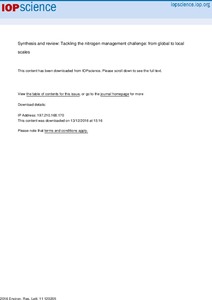| dc.contributor.author | Reis, S. |
| dc.contributor.author | Bekunda, Mateete A. |
| dc.contributor.author | Howard, C. |
| dc.contributor.author | Karanja, N. |
| dc.contributor.author | Winiwarter, W. |
| dc.contributor.author | Yan, X. |
| dc.contributor.author | Bleeker, A. |
| dc.contributor.author | Sutton, M.A. |
| dc.date.accessioned | 2019-12-04T11:04:38Z |
| dc.date.available | 2019-12-04T11:04:38Z |
| dc.date.issued | 2016-12-09 |
| dc.identifier.citation | Reis, S., Bekunda, M., Howard, C., Karanja, N., Winiwarter, W., Yan, X., ... & Sutton, M.A. (2016). Synthesis and review: Tackling the nitrogen management challenge: from global to local scales. Environmental Research Letters 11, 1-13. |
| dc.identifier.issn | 1748-9326 |
| dc.identifier.uri | https://hdl.handle.net/20.500.12478/1471 |
| dc.description | Open Access Journal |
| dc.description.abstract | One of the ‘grand challenges’ of this age is the anthropogenic impact exerted on the nitrogen cycle.
Issues of concern range from an excess of fixed nitrogen resulting in environmental pressures for some
regions, while for other regions insufficient fixed nitrogen affects food security and may lead to health
risks. To address these issues, nitrogen needs to be managed in an integrated fashion, at a variety of
scales (from global to local). Such management has to be based on a thorough understanding of the
sources of reactive nitrogen released into the environment, its deposition and effects. This requires a
comprehensive assessment of the key drivers of changes in the nitrogen cycle both spatially, at the
field, regional and global scale and over time. In this focus issue,we address the challenges of managing
reactive nitrogen in the context of food production and its impacts on human and ecosystem health.
In addition, we discuss the scope for and design of management approaches in regions with too much
and too little nitrogen. This focus issue includes several contributions from authors who participated
at the N2013 conference in Kampala in November 2013, where delegates compiled and agreed upon
the ‘Kampala Statement-for-Action on Reactive Nitrogen in Africa and Globally’. These contributions
further underline scientifically the claims of the ‘Kampala Statement’, that simultaneously reducing
pollution and increasing nitrogen available in the food system, by improved nitrogen management
offers win-wins for environment, health and food security in both developing and developed
economies. The specific messages conveyed in the Kampala Statement focus on improving nitrogen
management (I), including the reduction of nitrogen losses from agriculture, industry, transport and
energy sectors, as well as improving waste treatment and informing individuals and institutions (II).
Highlighting the need for innovation and increased awareness among stakeholders (III) and the
identification of policy and technology solutions to tackle global nitrogen management issues (IV),
this will enable countries to fulfil their regional and global commitments. |
| dc.format.extent | (1-13) |
| dc.language.iso | en |
| dc.subject | Anthropogenic |
| dc.subject | Food Production |
| dc.subject | Nitrogen Management |
| dc.subject | Food Security |
| dc.subject | Climate Change |
| dc.subject | Nitrogen Cycle |
| dc.title | Synthesis and review: tackling the nitrogen management challenge: from global to local scales |
| dc.type | Journal Article |
| dc.description.version | Peer Review |
| cg.contributor.crp | Climate Change, Agriculture and Food Security |
| cg.contributor.affiliation | Natural Environment Research Council, UK |
| cg.contributor.affiliation | University of Exeter |
| cg.contributor.affiliation | International Institute of Tropical Agriculture |
| cg.contributor.affiliation | University of Edinburgh |
| cg.contributor.affiliation | University of Nairobi |
| cg.contributor.affiliation | International Institute for Applied Systems Analysis |
| cg.contributor.affiliation | Institute of Soil Science |
| cg.contributor.affiliation | Netherlands Environmental Assessment Agency |
| cg.coverage.region | Africa |
| cg.coverage.region | East Africa |
| cg.coverage.country | Uganda |
| cg.isijournal | ISI Journal |
| cg.authorship.types | CGIAR and developing country institute |
| cg.iitasubject | Climate Change |
| cg.iitasubject | Soil Fertility |
| cg.journal | Environmental Research Letters |
| cg.howpublished | Formally Published |
| cg.accessibilitystatus | Open Access |
| local.dspaceid | 80520 |
| cg.targetaudience | Scientists |
| cg.identifier.doi | https://dx.doi.org/10.1088/1748-9326/11/12/120205 |

